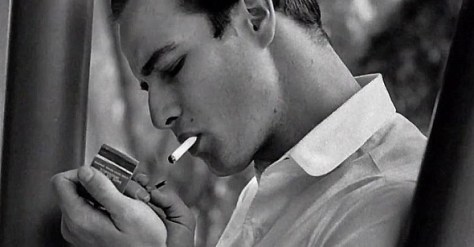By Dennis Hartley
(Originally posted on Digby’s Hullabaloo on August 22, 2015)

There are a lot of actors who have tried to be Marlon Brando over the years. God knows, they’ve tried (not that James Dean, Paul Newman, Robert De Niro, Al Pacino, Richard Gere, Mickey Rourke, Sean Penn, Tom Berenger, Johnny Depp, Nicholas Cage, Mark Ruffalo, Leonardo DiCaprio, Benicio Del Toro or Russell Crowe were/are slouches). In fact, since 1947, which is when a 23 year-old Brando exploded onto the American stage (and into eternal iconography) with his primal performance as Stanley Kolwalski in the original 2-year Broadway run of Tennessee Williams’ A Streetcar Named Desire, it’s likely the only young actor who hasn’t been influenced by Brando was…Marlon Brando.
He wasn’t “trying” to be anything. That’s because Brando simply “was”. You know the type. He was one of the casually gifted, who takes to acting (or music, writing, poetry, art, dance) like a fish to water, seemingly bereft of studiousness or discipline. And more often than not, they are bored (or at best, bemused) by any inquiry regarding, or any contemplation of…their “process”. Plying genius to craft holds equal import to making a peanut butter and jelly sandwich. Why, it’s enough to turn any of us into Antonio Salieri:
From now, we are enemies, you and I. Because You chose for Your instrument a boastful, lustful, smutty, infantile boy and gave me reward to only recognize the incarnation.
-Salieri addressing God, from Peter Shaffer’s screenplay for the 1984 film, Amadeus
So what did make Brando tick? How does one get a definitive portrait of an artist astutely encapsulated by Camille Paglia (in her 1991 New York Times Book Review critique of Richard Schickel’s Brando biography) as “arrogant and manipulative, seething with raw sensitivities and burning rage, alternately harsh and kind, selfish and generous…a monumental personality of profound complexities and contradictions”? Not an easy task.
Don’t ask me…I’m just an errand boy, sent by grocery clerks, to collect a bill. That’s why I leave it to the professionals, like documentary film maker Stevan Riley, who gives it a shot with Listen to Me Marlon (in limited release and eventually headed for Showtime). Using a gimmick similar to The Beatles Anthology (my review) or Kurt Cobain: About a Son (my review), Riley gives Morgan Freeman and Peter Coyote a breather and lets his subject do all of the talking, via carefully assembled sound bites culled from hours of archival interviews and private audio recordings (some of the latter surprisingly frank and intimate). Brando (in a matter of speaking) takes us on a tour of his life, from childhood, to fledgling days in New York as a stage actor, Method study under Stella Adler and through the (somewhat generalized) ups and downs of his movie career.
What’s glaringly absent are references to his tumultuous personal and family life; the various divorces, public custody battles and such (although there is a brief segment dealing with Brando’s testimony during the trial of his son Christian, who shot his half-sister’s boyfriend to death in 1990). There is a quick sound bite or two alluding to the legendary philandering, but if there were any extensive taped confessionals from Brando on that particular aspect of his personality, they remain on the cutting room floor (not surprising, given that this project was produced with the full blessing of Brando’s estate).
Where the film works best is when Brando talks about the craft (which he was famously loath to do). In a fascinating and perplexing segment, he recounts his experience working with Bernardo Bertolucci on Last Tango in Paris. A palpably embittered Brando claims that he was appalled to realize (only after seeing the final cut) that he had “let” the director dupe him into revealing an uncomfortable portion of his “true” self on screen, by incorporating events from his life that he allegedly shared in confidence (Brando was aware that he was making a movie, what with all the cameras and crew and stuff, right?).
Despite all of the “previously unseen” or “unheard” audio and video incorporated into the film, I didn’t find anything here necessarily revelatory; I would not call this a “definitive” portrait. Then again, is it possible to produce a “definitive” portrait of any person who makes their living pretending to be anybody but who they really are? Still, casual fans and film buffs should find this particular “version” of Mr. Brando perfectly serviceable.